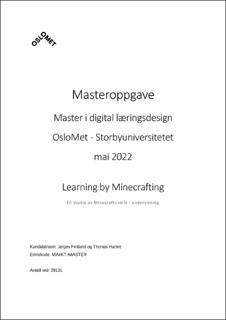| dc.contributor.advisor | Mifsud, Louise | |
| dc.contributor.advisor | Bertram Rustad, Mikkel | |
| dc.contributor.author | Fintland, Jørgen | |
| dc.contributor.author | Hamre, Thomas | |
| dc.date.accessioned | 2022-08-16T07:47:32Z | |
| dc.date.available | 2022-08-16T07:47:32Z | |
| dc.date.issued | 2022 | |
| dc.identifier.uri | https://hdl.handle.net/11250/3012013 | |
| dc.description.abstract | Mange barn og unge i Norge er opptatt av og bruker tid på digitale spill. Dette har ført til en økt interesse for potensialet til Digital Game Based Learning (DGBL), altså bruken av digitale spill i undervisningen. Forskningen indikerer at det er flere egenskaper ved digitale spill som talerfor at man kan bruke det i undervisning. Blant annet spillenes interaktivenatur, som gjør elevene til aktive deltakere i læringen når de samarneider om å utforske og løse utfordringer i spillet. Formålet med denne studien varå få ny kunnskap om hvilken rolle det digitale spillet Minecraft hari å skape samhandling og interaksjoner mellom elevene som en del av et undervisningsopplegg i samfunnsfag. Elevene fikk i oppgave å jobbe sammen i gruppermed å rekonstruere industribygg fra industrialiseringen i Norge og bruke disse industribyggene til å lage rollespill. Studiens problemstilling lyder som følger: Hvilken rolle har Minecraft i gruppeaktiviteter? Ved å bruke DGBL kan skolen bidra til at elevene erverver seg ferdigheter innenfor for eksempel samarbeid, kommunikasjon og problemløsning. Som er viktige ferdigheter i et fremtidig arbeidsliv. Videre viser forskningen at bruken av DGBL kan føre til økt engasjement og motivasjon blant elevene. Til tross for dette antyder forskningen at det fremdeles er negative holdninger knyttet til bruken av DGBL i skolen. Dennestudienerbygd på sekundærbruk av datamateriale, noe som innebærer at vi benyttetoss av datamateriale som haddeblitt samlet inn tidligere, uten at vi selv var til stede ellerdeltok under datainnsamlingen. Datamaterialetbestoav transkripsjoner og videoopptak av undervisningen med DGBL og intervjuer i etterkant av undervisningen. Studien er basert på en kvalitativ tilnærming til datamaterialet. Funnene viser at elevene på gruppene løste oppgaven med å rekonstruere bygninger fra industrialiseringen av Norge, for så å bruke bygningene som kulisser for rollespillet. Studiens funn indikerer at elevene hadde varierende forhåndskunnskaper i Minecraft, noe som fikk betydning for hvordan gruppene gikk frem for å løse oppgaven. Forskjellene i elevenes erfaring og ferdigheter i spillet fikk betydning for gruppene evne til å skape samhandling og interaksjoner mellom elevene. | en_US |
| dc.description.abstract | Many children and young people in Norway are interested in and spend time on digital games. This has led to an increased interest in the potential of Digital Game Based Learning (DGBL), the use of digital games in teaching. Research indicates that there are several characteristics of digital games that suggest that they can be used in teaching. Among other things, the interactive nature of the games, which make the students active participants in their own learning when they work together and collaborate to explore and solve challenges in the game. The purpose of this study was to gain new knowledge about the role of the digital game Minecraft when it is used in school in teaching social studies. This thesis focuses in understanding the role of Minecraft in interactions between students when they work in groups in reconstructing industrial buildings from industrialization in Norway and using these industrial buildings to create role-playing games. The study's research question is as follows: What role does Minecraft have in group activities? By using DGBL, the school can contribute to the students acquiring skills such as collaboration, communication and problem solving, which are important skills in a future working life. Furthermore, research shows that the use of DGBL can lead to increased commitment and motivation among students. Despite this, research suggests that there are still negative attitudes associated with the use of DGBL in schools. This study is based on the secondary use of data material, which means that we use data material that has been collected previously, without us being present or participating in the data collection. The data material consists of transcripts and video recordings of the teaching with DGBL and interviews after the teaching. The study is based on a qualitative approach to the data material. Findings indicate that the students in the groups solved the task of reconstructing buildings from the industrialization of Norway, and then using the buildings as scenery for the role play. The study's findings indicate that the students had varying prior knowledge of Minecraft, and consequently how the groups proceeded to solve the problem. The differences in the students experience and skills in the game had an impact on the groups' ability to create interaction and interactions between the students. | en_US |
| dc.language.iso | nob | en_US |
| dc.publisher | OsloMet - Storbyuniversitetet | en_US |
| dc.subject | Digital game-based learning | en_US |
| dc.subject | Computer-supported collabrative learning | en_US |
| dc.subject | Minecraft | en_US |
| dc.subject | Sosiokulturell læring | en_US |
| dc.title | Learning by Minecrafting - En studie av Minecrafts rolle i undervisning | en_US |
| dc.type | Master thesis | en_US |
| dc.description.version | publishedVersion | en_US |
| dc.source.pagenumber | 80 | en_US |
| dc.subject.nsi | VDP::Samfunnsvitenskap: 200::Pedagogiske fag: 280::Andre pedagogiske fag: 289 | en_US |
| dc.subject.nsi | VDP::Teknologi: 500::Informasjons- og kommunikasjonsteknologi: 550 | en_US |
